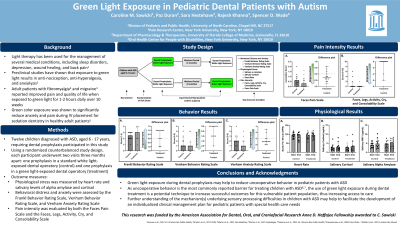Special Health Care Needs
326 - Green Light Exposure in Pediatric Dental Patients with Autism


Caroline Sawicki, DDS, PhD
Assistant Professor
University of North Carolina, Chapel Hill, NC
University of North Carolina
Chapel Hill, North Carolina, United States- PD
Paz Duran, PhD
New York University
- SH
Sara Hestehave, PhD
New York University
- RK
Rajesh Khanna, PhD
University of Florida College of Medicine
- SW
Spencer Wade, DDS, MS
New York University

Caroline Sawicki, DDS, PhD
Assistant Professor
University of North Carolina, Chapel Hill, NC
University of North Carolina
Chapel Hill, North Carolina, United States
Presenting Author(s)
Co-Author(s)
Program Director(s)
Purpose: The purpose of this study was to determine if green light exposure in the dental operatory, as compared to standard white light, reduces pain, distress, and anxiety in pediatric patients with autism spectrum disorder (ASD) undergoing a dental prophylaxis.
Methods: Twelve children diagnosed with ASD, aged 6-17 years, requiring a dental prophylaxis participated in this study. Using a randomized counterbalanced study design, each participant underwent two visits three months apart: one prophylaxis in a standard white light-exposed dental operatory (control) and one prophylaxis in a green light-exposed dental operatory (treatment). Physiological stress was measured by heart rate variability and salivary levels of alpha amylase and cortisol. Behavioral distress and anxiety were assessed by the Frankl Scale, Venham Behavior Rating Scale (VBRS), and Venham Anxiety Rating Scale. Pain intensity was evaluated by both the Faces Pain Scale and the Faces, Legs, Activity, Cry, and Consolability Scale.
Results: There was a trend towards reduced uncooperative behavior by the VBRS when children received a prophylaxis in the green light-exposed dental operatory (P=.06). Similar levels of heart rate variability (P=.41), salivary alpha amylase (P=.19), and salivary cortisol (P=.67) were observed at the start and end of each visit in both conditions. Green light exposure had no significant effect on pain intensity (P=.17), behavioral anxiety (P=.31), or behavioral cooperation by the Frankl scale (P=.18).
Conclusions: These findings suggest a preliminary positive benefit of green light exposure on behavioral outcomes in pediatric patients with ASD and warrants a further, large-scale clinical trial.
Identify Supporting Agency and Grant Number:
Research supported by the American Association for Dental, Oral, and Craniofacial Research Anne D. Haffajee Fellowship awarded to C.M. Sawicki

.jpg)